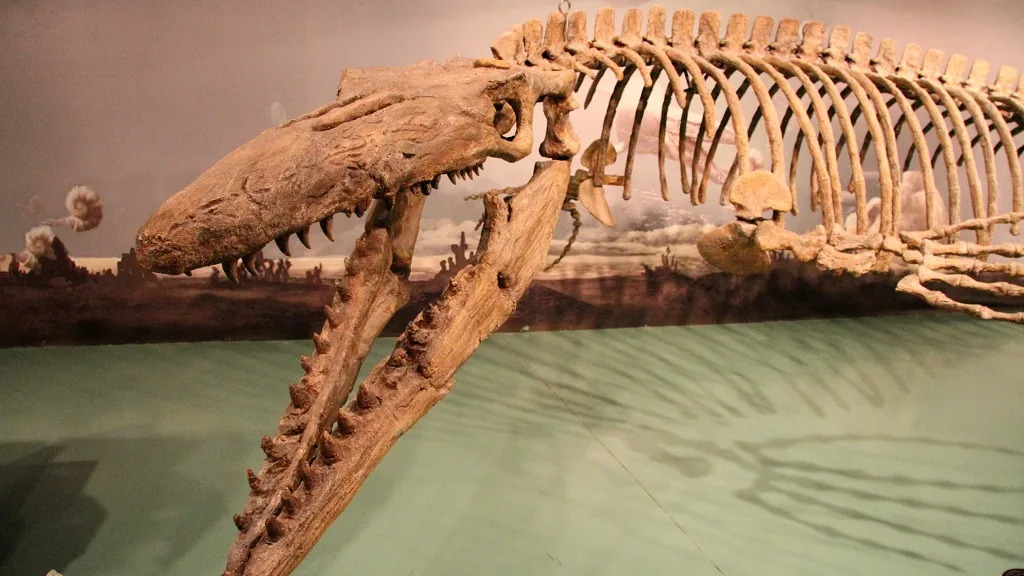Brendan Rascius
Thu, December 14, 2024

Paleontologists discovered the fossilized remains of an aquatic “dragon” that prowled the Pacific Ocean millions of years ago.
The monstrous predator — which measured as long as a great white shark — belongs to a brand new species, according to a Dec. 12 University of Cincinnati news release.
Takuya Konishi, a paleontologist at the university, came upon the creature’s near perfectly intact fossilized remains in southwestern Japan in 2006.
“It was something I had never seen before,” Konishi said in the news release.
Discover more new species
Thousands of new species are found each year. Here are three of our most eye-catching stories from the past week.
→ ‘Limbless’ creature found digging beneath rotten tree in Vietnam
→ Four-eyed creature with ‘spherical’ sex organ found in China
→ Sea creature with 328 tentacles found suctioned to rock in Japan
After spending years carefully extracting the fossils from surrounding sandstone, he and other researchers have now described their findings in a study published in the Journal of Systematic Palaeontology.
The creature is a type of mosasaur, a family of large marine reptiles that lived up to 100 million years ago, researchers said. Like the Tyrannosaurus rex and most other dinosaurs, it went extinct when a large asteroid struck the Gulf of Mexico 66 million years ago.
Chimera-esque in form, it had a “crocodile-like head,” four “wing-shaped flippers” and a finned tail.
This combination of features is unique, and it’s not clear exactly how they were used together for propulsion and steering.
“We lack any modern analog that has this kind of body morphology — from fish to penguins to sea turtles,” Konishi said in the release. “None has four large flippers they use in conjunction with a tail fin.”
The newfound mosasaur also had extremely good vision which would have allowed it to be a “lethal hunter,” he said.
The mosasaur was given the name Megapterygius wakayamaensis after Wakayama, the Japanese prefecture in which it was discovered.
But researchers have a second, more sensational name for it: Wakayama Soryu, or “blue dragon,” a fitting name as dragons are a part of Japanese folklore.
“In China, dragons make thunder and live in the sky,” Konishi said in the release. “They became aquatic in Japanese mythology.”
The fossilized remains of the “dragon” may be shown in an exhibition in the coming year, Masaaki Ohara, who was involved in the excavation, told the Japanese newspaper Asahi Shimbun.
Mosasaur fossils have been found all over the world, including in Poland, South Africa and the United States.
These huge Japanese 'dragons' hunted the ancient oceans
Bryan Ke
Fri, December 15, 2023

[Source]
University of Cincinnati Associate Professor Takuya Konishi and international colleagues have classified a reptile whose remains were found in Japan 17 years ago as a new species.
About the predator: Akihiro Misaki discovered fossils of the mosasaur, an ancient apex predator, along the Aridagawa River in Wakayama Prefecture, Japan, in 2006 while searching for ammonite fossils for his doctorate thesis. In a study published Monday in the Journal of Systemic Paleontology, Konishi, Misaki and their team referred to the discovery as the "Wakayama Soryu" or "Wakayama Blue Dragon."
The specimen happens to be the most complete skeleton of a mosasaur found in Japan or the northwestern Pacific. Mosasaurs were large aquatic reptiles about the size of great white sharks from the Cretaceous period in the late Mesozoic Era that terrorized oceans 100 to 66 million years ago.
A new species: The researchers determined that the remains belonged to a new species of the mosasaur. They noted its unique features, such as rear flippers larger than its crocodile-like head, which suggest that it swam using its leg fins.
Trending on NextShark: Teenage law clerk becomes youngest person to ever pass California bar exam
After classifying the discovery under the Mosasaurinae subfamily, the researchers identified it as the Megapterygius wakayamaensis. Megapterygius means “large flippers.”
Based on the shape of its spine, the researchers also believe that the Wakayama Soryu had a dorsal fin — another distinctive feature. They noted that it was similar to that of a harbor porpoise.
Why it matters: Konishi, who has studied mosasaurs for more than 15 years, said the discovery has opened “a whole can of worms” that challenges experts’ understanding on how the prehistoric reptiles swim.
Trending on NextShark: Japanese man who spent $16,000 to become a dog 'fails' agility test
“I thought I knew them quite well by now,” Konishi added. “Immediately it was something I had never seen before.”
No comments:
Post a Comment